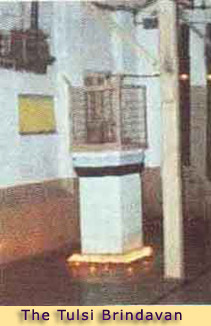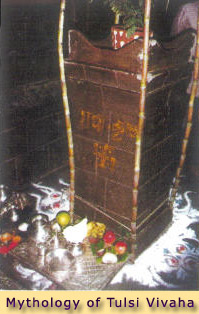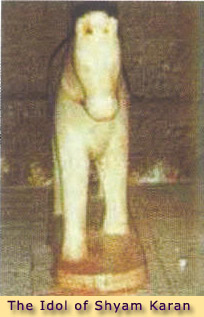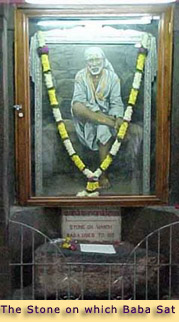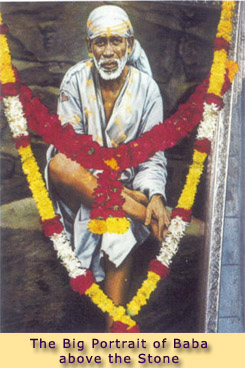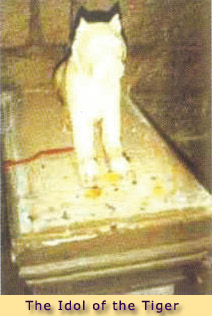DWARAKAMAI (MASJID) |
||
THE TULSI BRINDAVAN Baba planted this Tulsi Brindavan outside the Masjid. After the outer pavilion was constructed, the devotees brought this Tulsi Brindavan inside and tended to it. It now stands in the North East Corner and is looked after by the Pujari of Dwarakamai. As it is under the roof of the Dwarakamai its nourishment is not up to the mark for lack of sunshine. Every year Tulsi Vivah is done on the 12th day of Diwali.
The Mythology of Tulsi Vivaha On Karthika Shukla Dwadashi which is the 12th day of the bright fortnight of the month of Karthika (October and November), which is also known as Uthana Dwadashi, the Tulsi Vivaha takes place. Jalandhara was a powerful Asura, and was a threat to the Suras or Gods. The secret of his mighty power was his chaste and devout wife Brinda. The Gods requested Vishnu to save them; Vishnu impersonated Jalandhara and went to her. Brinda having lost her chastity, Jalandhara lost his power and met his end. When Brinda came to know of this she cursed Vishnu. Vishnu then repented and sat next to her on the funeral pyre of her husband.
By Parvati’s grace the funeral pyre was converted into a beautiful garden. The garden was full of Tulsi, Amla (Indian Gooseberry) and Jaie (a type of fragrant Jasmine). Out of these the Tulsi plant is Brinda. Hence, the garden is known as Tulsi Brindavan. Brinda who committed Sati became Rukmini, in her next reincarnation and married Krishna on Karthika Shulkla Dwadashi. In Shirdi, Tulsi Vivaha is performed in the Dwaraka Mai on the 12th day of Diwali. The priests from the Samadhi Mandir come to the Dwarakamai to perform the marriage. The devotees can participate in the marriage. A new healthy Tulsi plant is brought and the old one is replaced. The plant is dressed like a bride in a small green saree. Small green bangles adorn the branches of the plant. Then the marriage takes place between Krishna and the Tulsi with due rituals. After the marriage ceremony is completed, the devotees assembled there are given Bathasa, whole coriander and savouries that are made for the festival of Diwali. It is a very joyous occasion.
THE IDOL OF SHYAM KARAN – THE HORSE Kasim, a horse merchant, was distraught because his mare had no issue for a very long time. He vowed to Baba that if his mare had a foal, he would offer the first born to Baba. By Baba's grace the mare did have a series of issues. So he came and presented Baba with the first born. Baba called the horse “Shyam Karan”as his body was brown while his ears were black. Many devotees called this Horse "Shyam Sunder". The horse loved Baba and Baba reciprocated. The trainer Khajgiwalle saw that the horse was well looked after and decorated. This horse was housed in the room situated on the eastern side of Dwarakamai; now called “Shyam Sunder Hall”.
At every Aarti the horse would stand in the Sabha Mandap (where the tortoise is now) and wait patiently for the Aarti to start. When the Aarti was begun he danced merrily keeping beat with the tiny bells tied to his feet. After Baba's Lalkari he would climb the central steps of Dwarakamai and bow to Baba. Baba blessed him by applying Udi to his forehead, then all the other Bhaktas received Udi and Prasad. On Chavadi procession days he was fully decorated with mala, leg rings, bells and a beautiful cloth for his tail. All his decorative articles are now kept in the Museum. It was a sight worth seeing as he danced all the way to Chavadi leading the procession. After Baba entered the Chavadi he stood outside facing Baba. After Baba's Mahasamadhi he would dance in the Samadhi Mandir during the Aartis and also participate in the Chavadi procession. This beloved horse of Baba died in 1945 and his Samadhi is built by Saibaba Sansthan in Lendi Bagh. Bala Saheb Sulthe of Shirdi presented this idol of Shyam Karan. It was installed on the left side of the stone on which Baba sat. The Rinanubandh between Baba and Shyam Karan was very deep. This statue was in remembrance of the deep love that Shyam Karan had for Baba and the love that Baba had reciprocated. THE STONE ON WHICH BABA SAT This stone is placed in the center of the eastern wall of Dwarakamai near the Sabhamandap. Baba used to sit on this stone facing west. Marble Padukas were installed on this stone. Now the marble padukas have been replaced with Silver Padukas. Baba often sat in the Sabhamandap. It was the portico in front of the Sanctum Sanctorum (Dwarakamai). There Baba sat on this stone. First this stone was adjacent to the Dwarakamai. Later it was moved to the eastern wall.
The legend has it, that this stone was in Lendi Bagh. Abdullah, like the other villagers, used to wash clothes on it. Then they saw Baba sitting on it. So they brought it to Dwarakamai and venerated it as Baba's Asan. Once a Pehelvan (Body Builder), who was extremely proud of his strength came to Shirdi. Baba casually asked him to move the stone, from its original place to where it is now. But every after trying for a long time the stone did not budge an inch. The Pehelvan stood silently looking at the stone and then at Baba. Then Baba laughed and with his Satka played with it as if it was a small ball. Then with three small steps he moved it to the eastern wall. Needless to say the Pehelvan was humbled and returned home (Refer Saibaba Hach Chamatkar by Dr.Keshav B.Gavankar). THE BIG PORTRAIT OF BABA ABOVE THE STONE D.D. Neroy of Bombay was a great devotee of Baba. He was a photographer and artist. He made many photo prints of Baba with one of the eleven sayings printed below. Usually he would write, "If you look to Me, I look to you ". He sold these photographs to various Companies and temples. D.D.Neroy was devoted to Kamu Baba (a saint at Girgaon, Mumbai). He got this portrait of Baba sitting on the stone made and mounted it in an ornate frame. Then with the help of four men he took it to Girgaon and offered it to his Guru. Kamu Baba appreciated the portrait and the kind gesture, but he refused to accept it. He told Neroy to take it to Shirdi, and place it in the Sabhamandap of the Dwarakamai. Dejected he sat at his Guru’s feet and said “it took me three years to make this portrait and one and a half months to get it framed. Never mind the expense, now you reject it?”. To this, Kamu Baba calmly said, “It is not a question of rejecting it, but a keen desire that you take it to Shirdi and place it where thousand upon thousands of devotees will have the benefit of praying to it”. Thus, this portrait came to be installed in the Sabhamandap of the Dwarakamai.
The dimensions of this photograph are 6’ by 4’. Originally it had a wooden frame, later the silver frame. Recently it has been enclosed in a glass door cupboard like frame to preserve it. Before Kakad Aarti the priest does Alankar (decorates it) with Ashtagandh and garlands it. Baba has given Sakshatkar (darshan) from this photo with blessings and healings. D.D.Neroy had signed only one photo of Baba and this photo is placed in the Mangal Karyalay of Sansthan. THE STATUE OF TIGER This Statue is on the right side of the stone on which Baba sat. It was Installed on 12.11.1969 by the Sansthan and presented by Triambakrao Shripathrao Shiladhar of Ozar village. Seven days before Baba took Mahasamadhi the Leela of giving a sick tiger Sadgati is vividly described (Refer Shri Sai Satcharitra Chapter 31). The details are given under the heading “The Samadhi of the Tiger”. This tiger was brought to Baba with the view to its cure by three Darveshis. After permission was taken they brought the tiger that climbed the steps of Dwarakamai, and looked at Baba lovingly. Suddenly it moved the tuft of its tail and dashed it against the ground thrice and fell and died. With this Darveshis got upset and Baba gave them Rs.50/- and consoled them. Thus the debt was paid and it met its end at Baba's holy feet attaining Sadgati. Baba not only gave Sadgati to men but also to beasts alike.
The tiger died in the Dwarakamai at Baba’s feet, then how could he ever be reborn? The Samadhi of this tiger is in front of Mahadev temple in the old Shanti Niwas premises inside Temple Complex. |
||
(Courtesy: Ambrosia in Shirdi and Baba’s Gurukul by Vinny Chitluri). |
||
© 2011 Saiamrithadhara.com. All Rights Reserved. |
